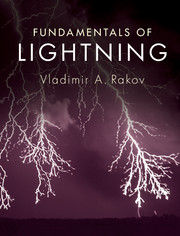Book contents
- Frontmatter
- Dedication
- Contents
- Preface
- 1 Types of lightning discharges and lightning terminology
- 2 Incidence of lightning to areas and structures
- 3 Electrical structure of thunderclouds
- 4 Properties of the downward negative lightning discharge to ground
- 5 Calculation of lightning electromagnetic fields
- 6 Modeling of the lightning return stroke
- 7 Measurement of lightning electric and magnetic fields
- 8 Electromagnetic methods of lightning location
- 9 Lightning damaging effects and protective techniques
- Appendices
- Appendix 1 How is lightning initiated in thunderclouds?
- Appendix 2 Reconstruction of sources from measured electrostatic field changes
- Appendix 3 Derivation of exact equations for computing lightning electric and magnetic fields
- Appendix 4 Compact intracloud discharges (CIDs)
- Appendix 5 Is it true that lightning never strikes the same place twice?
- Appendix 6 Is it possible to use lightning as an energy source?
- Appendix 7 Lightning safety
- Appendix 8 Lightning makes glass
- Appendix 9 Bibliography on triggered lightning experiments and natural lightning observations at Camp Blanding, Florida (1995–2014)
- Glossary
- References
- Index
Appendix 1 - How is lightning initiated in thunderclouds?
from Appendices
Published online by Cambridge University Press: 05 April 2016
- Frontmatter
- Dedication
- Contents
- Preface
- 1 Types of lightning discharges and lightning terminology
- 2 Incidence of lightning to areas and structures
- 3 Electrical structure of thunderclouds
- 4 Properties of the downward negative lightning discharge to ground
- 5 Calculation of lightning electromagnetic fields
- 6 Modeling of the lightning return stroke
- 7 Measurement of lightning electric and magnetic fields
- 8 Electromagnetic methods of lightning location
- 9 Lightning damaging effects and protective techniques
- Appendices
- Appendix 1 How is lightning initiated in thunderclouds?
- Appendix 2 Reconstruction of sources from measured electrostatic field changes
- Appendix 3 Derivation of exact equations for computing lightning electric and magnetic fields
- Appendix 4 Compact intracloud discharges (CIDs)
- Appendix 5 Is it true that lightning never strikes the same place twice?
- Appendix 6 Is it possible to use lightning as an energy source?
- Appendix 7 Lightning safety
- Appendix 8 Lightning makes glass
- Appendix 9 Bibliography on triggered lightning experiments and natural lightning observations at Camp Blanding, Florida (1995–2014)
- Glossary
- References
- Index
Summary
Maximum electric fields typically measured in thunderclouds (see Table 3.2 of Rakov and Uman (2003) and references therein) are 1–2 × 105 V/m (the highest measured value is 4 × 105 V/m), which is lower than the expected conventional breakdown field, of the order of 106 V/m. Two mechanisms of lightning initiation have been suggested. One relies on the emission of positive streamers from hydrometeors when the electric field exceeds 2.5–9.5 × 105 V/m, and the other involves high-energy cosmic ray particles and the runaway breakdown that occurs in a critical field, calculated to be about 105 V/m at an altitude of 6 km. Either of these two mechanisms permits, in principle, creation of an ionized region (“lightning seed”) in the cloud that is capable of locally enhancing the electric field at its extremities. Such field enhancement is likely to be the main process leading to the formation (via conventional breakdown) of a hot, self-propagating lightning channel.
Conventional breakdown
According to the conventional breakdown mechanism, lightning is initiated via the emission of positive corona from the surface of precipitation particles, highly deformed by strong electric fields in the case of raindrops, coupled with some mechanism whereby the electric field is locally enhanced to support the propagation of corona streamers. Positive streamers are much more likely to initiate lightning than negative ones because they can propagate in substantially lower fields. The most detailed hypothetical scenario of lightning initiation via conventional breakdown is described by Griffiths and Phelps (1976b), who consider a system of positive streamers developing from a point on a hydrometeor where the electric field exceeds the corona onset value of 2.5–9.5 × 105 V/m (2.5–9.5 kV/cm). The developing streamers are assumed to form a conical volume that grows longitudinally. The ambient electric field in the thundercloud required to support the propagation of corona streamers, E0, was found by Griffiths and Phelps (1976a) from laboratory experiments to be 1.5 × 105 V/m (1.5 kV/cm) at about 6.5 km and 2.5 × 105 V/m (2.5 kV/cm) at about 3.5 km. If the ambient electric field is higher than E0, the streamer system will intensify, carrying an increasing amount of positive charge on the propagating base of the cone, which simulates the positive streamer tips, and depositing an equally increasing amount of negative charge in the conical volume which represents the trails of the positive streamers.
- Type
- Chapter
- Information
- Fundamentals of Lightning , pp. 193 - 196Publisher: Cambridge University PressPrint publication year: 2016



